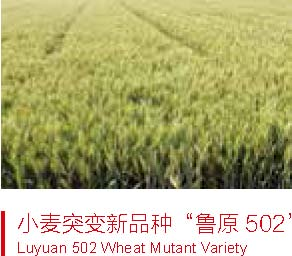Mutation Breeding
Interest in induced mutation breeding has spiked in China. The technology has been increasingly applied for crop improvement. Research in this field has been a joint effort spanning many sectors, including agriculture, research institutions and universities. More than 40 entities are involved. Cooperation and coordination have yielded remarkable results, placing China at the forefront of research on the application of this technology. As a member of the Steering Committee of the Plant Mutation Breeding Network for Asia and the Pacific, China has long been taking a leading role in implementing cooperative projects under the framework of the Regional Co-operative Agreement for Research, Development and Training Related to Nuclear Science and Technology.
A total of 1,050 mutant crop varieties have been developed in China by using radiation mutation breeding, accounting for one fourth of all mutants currently listed in the IAEA/FAO's database of mutant varieties produced worldwide. Annually, about 8-10% of the main crop varieties used in agricultural production come from a radiation-induced mutation process. An attempt was made to leverage space technologies in seed breeding, through 17 space trips and the launch on September 9, 2006 of China's seed-breeding satellite, Shijian-8, leading to the development of new types of high-quality germplasm, including dozens of new crop (rice, wheat, tomato, green pepper and sesame) varieties.


農作物誘變育種
中國農作物誘變育種技術研究發展迅速,在研究和發展誘變技術的同時,將該技術與農作物改良密切結合。通過組織全國農、科、教行業大聯合、大協作,形成了一支包括40多個單位的國家核輻射誘變技術育種研發隊伍,促進了核輻射誘變技術育種的持續發展,使中國的核輻射誘變技術及其育種應用研究一直走在世界前列,為國際原子能機構亞太地區植物誘變育種項目的牽頭國、亞太區域植物突變研究協作網依托國。
中國利用核技術誘變已育成了1050個突變品種,占國際原子能機構 /糧農組織全球突變品種數據庫所列突變品種的1/4。每年在生產上應用的主要農作物品種數量、播種面積里,8%~10%來自輻射誘變育種。通過17次太空搭載和2006年9月9日實踐八號衛星選育出一批優異新種質、新材料,包括水稻、小麥、番茄、青椒和芝麻等幾十個農作物新品種。
